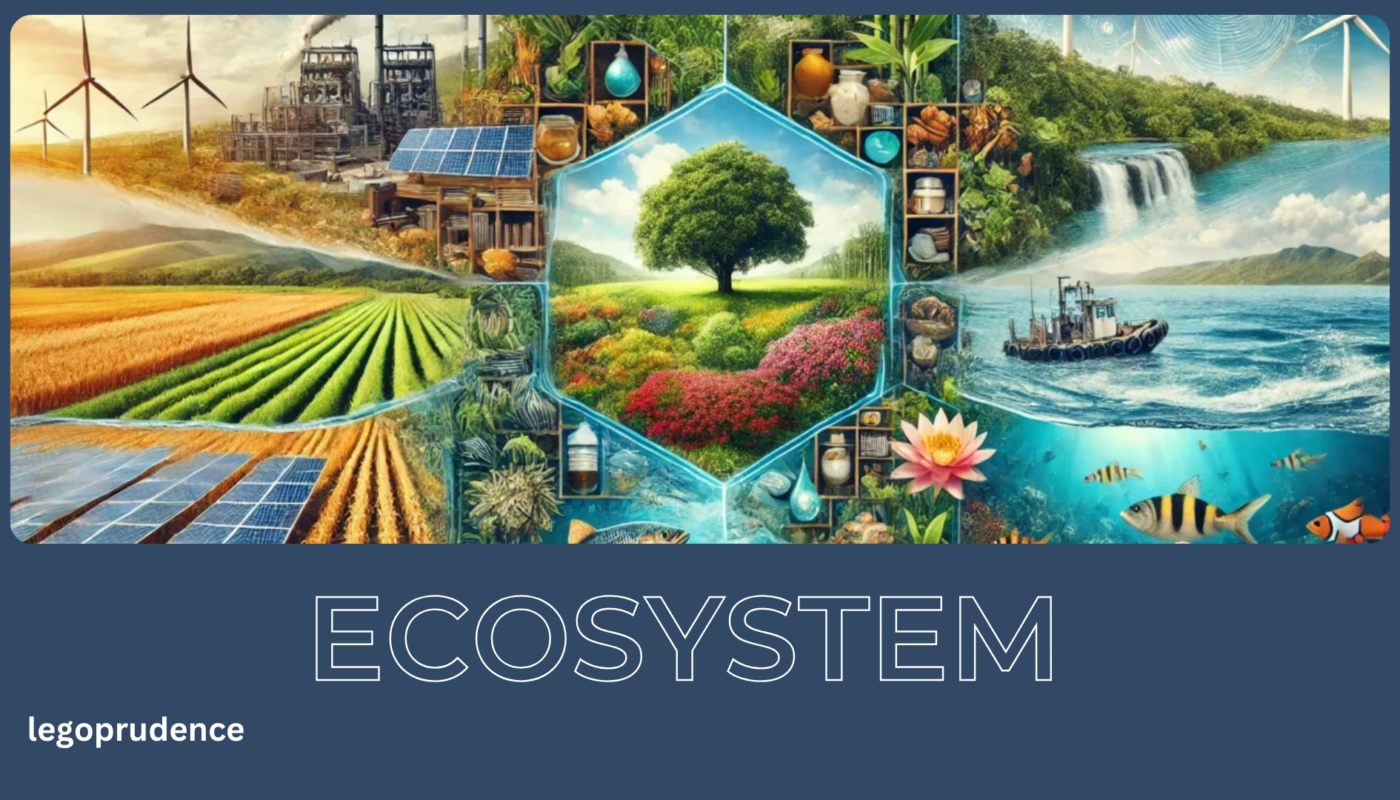Ecosystem Definition
“An ecosystem is defined as a community of lifeforms in concurrence with non-living components, interacting with each other.”
An ecosystem consists of a community of living organisms and their interactions with non-living components of the environment, operating as a unified system. These biotic (living) and abiotic (non-living) elements are interconnected through cycles of nutrients and flows of energy.
Energy enters the ecosystem through photosynthesis, where it is stored in plant tissues. Animals are essential for transferring matter and energy throughout the system and also impact the levels of plant and microbial biomass.
Decomposers are crucial for breaking down dead organic matter, releasing carbon into the atmosphere and facilitating nutrient cycling by transforming nutrients from dead biomass into forms that plants and microbes can use.
Ecosystems are shaped by both external and internal factors. External factors, such as climate, soil composition, and topography, influence the overall structure of an ecosystem without being affected by it. In contrast, internal factors—including decomposition, root competition, shading, disturbances, succession, and the types of species present—are influenced by the ecosystem itself.
Ecosystems are dynamic entities that undergo periodic disturbances and can recover from previous disruptions. Ecosystems in similar environments across different geographical areas may function quite differently due to variations in the species present.
Internal factors not only govern ecosystem processes but are also influenced by them, often creating feedback loops.
Resource inputs are largely determined by external influences such as climate and soil composition, while internal factors manage resource availability within the ecosystem. Although humans interact with ecosystems, their cumulative effects can significantly alter external factors like climate.
Biodiversity is vital for ecosystem functioning, along with processes like disturbances and succession. Ecosystems provide a variety of goods and services that are crucial for human life.
Ecology, the scientific study of interactions among populations and their environments, can be explored at several levels: individual, population, community, or ecosystem.
At the individual level, ecology primarily focuses on the physiology, reproduction, and development of individual organisms. At the population level, it investigates the characteristics and various factors that influence population dynamics.
At the community level, ecology examines the interactions between different populations and the patterns that arise within communities. At the ecosystem level, ecology integrates all these elements to gain a comprehensive understanding of how the entire system functions as a whole. Consequently, ecosystem ecology focuses more on energy flow and nutrient cycling rather than on specific individual species.
Structure of an Ecosystem
The structure of an ecosystem consists of two primary components: biotic and abiotic.
Biotic Components
Biotic components encompass all living organisms within an ecosystem, which can be categorized into two major types: eukaryotes and prokaryotes.
- Eukaryotes: These organisms possess membrane-bound organelles, including a nucleus within their cells. Examples include:
- Plants: They have chloroplasts that enable photosynthesis, allowing them to capture light energy and convert carbon dioxide and water into sugars. This process positions plants as primary producers, forming the base of the food web.
- Animals: They are classified as consumers. Animals that primarily feed on plants are known as herbivores, while those that consume other animals are called carnivores. Omnivores are those that eat both plants and animals.
- Fungi and Protists: These organisms also play vital roles in ecosystems, including decomposition and nutrient cycling.
- Prokaryotes: These organisms lack membrane-bound organelles and include bacteria and archaea. They are essential for various ecological functions, such as decomposition and nutrient cycling.
Abiotic Components
Abiotic components consist of all non-living elements in an ecosystem, including rocks, soil, minerals, water sources, and the atmosphere. Like biotic components, abiotic factors also fulfill critical ecological roles.
- Nutrient Sources: Elements and compounds from abiotic components provide essential nutrients necessary for the growth and metabolism of organisms.
- Habitat: Abiotic components create environments where organisms can live and thrive. Factors such as soil quality, water availability, and climate conditions influence the types of biotic components that can exist within an ecosystem.
Together, the biotic and abiotic components interact to form a complex web of relationships, supporting the overall functioning and stability of the ecosystem.
Types of Ecosystems
Ecosystems can be classified into four main types: terrestrial, freshwater, marine, and artificial. The first three occur naturally across various biomes, while the fourth is created by human activity. Ecosystems can range in size from micro-ecosystems to vast ocean ecosystems.
Terrestrial Ecosystems
Terrestrial ecosystems are those that exist on land and include several types:
- Forest Ecosystems: These ecosystems are characterized by a variety of plants, especially trees. The abundance of plant life supports a rich diversity of animals and provides resources like fruits and wood. Forests help regulate the Earth’s temperature and act as significant carbon sinks.
- Grassland Ecosystems: Typically found in tropical or temperate regions, grasslands are dominated by grasses. Common inhabitants of these ecosystems include grazing animals such as cattle, goats, and deer.
- Tundra Ecosystems: Known for their treeless and snow-covered landscape, tundra ecosystems experience melting snow in spring and summer, creating shallow ponds. During this time, lichens and flowering plants flourish. The ice covering the tundra plays a crucial role in regulating temperature and serves as a water reservoir.
- Desert Ecosystems: Found in arid regions, deserts are characterized by dry and windy conditions, with features like dunes, sand, and rock. While biodiversity is lower in deserts compared to forests, organisms have adapted to thrive in these harsh conditions. Common desert plants include CAM plants, such as cacti, while typical animals include insects, reptiles, and birds.
Freshwater Ecosystems
Freshwater ecosystems are aquatic environments that lack saltwater and support a variety of life forms, including algae, plankton, insects, amphibians, and fish. These ecosystems can be divided into two main types:
- Lentic Ecosystems: These are ecosystems found in still waters, such as ponds, puddles, and lakes. Lakes often exhibit zonation, including:
- Littoral Zone: The area near the shore, rich in rooted plants.
- Limnetic Zone: The open water where light penetration varies, further divided into:
- Photic Zone: The light-penetrated area.
- Benthic Zone: The dark, bottom layer where light does not reach.
- Lotic Ecosystems: These ecosystems consist of freely flowing freshwater habitats, such as rivers and streams. Organisms in lotic systems exhibit adaptations to cope with the challenges posed by moving water.
Marine Ecosystems
Marine ecosystems are aquatic environments characterized by saltwater, including seas and oceans. They are essential for global ecology and serve as significant sources of atmospheric oxygen, primarily due to the extensive populations of autotrophic algae that perform photosynthesis. Marine ecosystems are considered the most abundant type of ecosystem worldwide.
Artificial Ecosystems
Artificial ecosystems are human-made environments that can be classified as terrestrial, freshwater, or marine. An example of an artificial ecosystem is a terrarium. These ecosystems are often created for purposes such as conservation, aesthetic enjoyment, or educational research in biology and ecology.
Functions of Ecosystems
Ecosystems operate under the influence of both external and internal factors. External factors, known as state factors, shape an ecosystem’s overall structure and functioning but are not influenced by the ecosystem itself. Important external factors include time and potential biota, which can significantly impact how ecosystems function. Even ecosystems in similar environments can exhibit different behaviors due to variations in the species present.
In contrast, internal factors control the processes within ecosystems and are also affected by those processes, often resulting in feedback loops. While external factors, like climate and substrate, dictate resource inputs, the availability of these resources is managed by internal processes, such as decomposition, competition among roots, and shading. Other internal factors include disturbances, ecological succession, and the types of species present.
Primary Production
Primary production refers to the generation of organic matter from inorganic carbon sources, primarily through photosynthesis. This process not only supports life on Earth but also contributes significantly to the carbon cycle, affecting global climate through the greenhouse effect. During photosynthesis, plants absorb energy from light and combine carbon dioxide and water to create carbohydrates and oxygen. The total photosynthesis performed by all plants in an ecosystem is termed gross primary production (GPP).
Energy Flow
Energy and carbon enter ecosystems via photosynthesis, becoming part of living tissues. This energy is then transferred to organisms that feed on both living and dead plant matter, eventually being released through respiration. The carbon and energy stored in plant tissues (net primary production) can be consumed by animals while the plant is alive or remain uneaten, turning into detritus once the plant dies. In aquatic systems, herbivores tend to consume a larger proportion of plant biomass compared to terrestrial ecosystems.
Decomposition
Decomposition is the process by which dead organic matter is broken down into simpler organic or inorganic substances, such as carbon dioxide, water, simple sugars, and mineral salts. This process releases nutrients for reuse by plants and microbes while returning carbon dioxide to the atmosphere for photosynthesis. Without decomposition, dead organic matter would accumulate, depleting nutrients and atmospheric carbon dioxide.
Decomposition can be categorized into three main processes:
- Leaching: Water dissolves and carries away water-soluble components from dead organic matter, which can then be utilized by soil organisms or transported beyond the ecosystem’s boundaries.
- Fragmentation: The physical breakdown of dead material into smaller pieces.
- Chemical Alteration: Changes to the chemical structure of dead materials.
The rate of decomposition is influenced by factors such as temperature, moisture, soil properties, the quantity and quality of dead material, and the composition of the microbial community.
Nutrient Cycling
Ecosystems constantly exchange energy and carbon with their surroundings, while mineral nutrients predominantly cycle among plants, animals, microbes, and soil. Nitrogen is introduced into ecosystems primarily through biological fixation, precipitation, and fertilizer application. Since most terrestrial ecosystems are nitrogen-limited, nitrogen cycling plays a crucial role in ecosystem productivity.
Nitrogen-fixing bacteria, which can live symbiotically with plants or freely in the soil, are a significant source of nitrogen. Other sources include acid deposition from fossil fuel combustion and ammonia gas from agricultural fertilizers. When plant tissues are shed or consumed, the nitrogen within them becomes available to other organisms. Microbial decomposition releases nitrogen compounds into the soil, where competition for these nutrients occurs among plants, fungi, and bacteria. Processes such as nitrogen mineralization and nitrification further influence nitrogen cycling.
Other essential nutrients, including phosphorus, calcium, sulfur, potassium, manganese, and magnesium, also cycle through ecosystems, primarily through weathering and biological interactions.
Function and Biodiversity
Biodiversity is crucial for ecosystem functioning, as it affects the processes driven by the number of species, their specific traits, and their relative abundances. Ecosystem processes are influenced by individual organisms’ actions. Ecological theory posits that to coexist, species must exhibit some level of limiting similarity, which prevents competitive exclusion. Adding ecologically similar species has minimal impact on ecosystem function, while distinct species can significantly influence it. Keystone species and ecosystem engineers, which modify habitats, can have disproportionately large effects on ecosystem dynamics.
Dynamics
Ecosystems are dynamic entities that experience periodic disturbances and continuously recover from past disruptions. When a disturbance occurs, an ecosystem may shift away from its initial state, with its ability to return to equilibrium referred to as resistance.
Disturbances, such as tree falls, insect outbreaks, hurricanes, wildfires, and volcanic eruptions, can drastically alter the structure of populations, communities, and ecosystems. The aftermath of a disturbance often leads to ecological succession, which is the directional change in ecosystem structure and functioning driven by biotic changes in resource supply.
The frequency and severity of disturbances dictate their impact on ecosystem function. Major disturbances, like volcanic eruptions, result in primary succession, where ecosystems develop in areas devoid of soil and organic matter. In contrast, less severe disturbances, such as forest fires, typically lead to secondary succession, allowing for faster recovery.
Productivity
In ecology, “productivity” refers to the speed at which biomass is generated within an ecosystem. This is typically measured in units of mass per area per time (g m⁻² d⁻¹). Productivity can be categorized as either primary or secondary.
Primary productivity pertains to the output of autotrophs, such as plants, while secondary productivity relates to heterotrophs, like animals. The primary production of biomass is primarily attributed to the photosynthesis performed by plants and algae, as they are the initial source of energy for other organisms.
Plants capture energy from the sun through chloroplasts in their cells. Within these chloroplasts, the light energy from photons drives the conversion of inorganic materials into energy reserves, such as sugar.
Animals lack the pigments necessary for capturing light energy to perform photosynthesis, which means they must depend on autotrophs or other heterotrophs for their sustenance.
Photosynthesis is a biological process enabling plants to create their food using sunlight and inorganic substances, resulting in the production of glucose. These plants then serve as a food source for organisms that cannot produce their own food.
As animals consume these plants, energy is transferred from producers to consumers, and subsequently from one consumer to another. The complex organic molecules found in food, including carbohydrates, fats, and proteins, are rich in energy stored within their chemical bonds.
In aerobic conditions, glucose undergoes processing to generate chemical energy (ATP) through cellular respiration. This process releases energy stored in food molecules via a series of oxidation reactions, with electrons moving from one molecule to another until they reach oxygen, the final electron acceptor. The complete oxidation of the food molecule results in carbon dioxide, which is expelled through plant stomata during transpiration and through animals during respiration. In anaerobic conditions, cells resort to fermentation, breaking down glucose to produce ATP and lactic acid.
Decomposers represent the final group of organisms through which energy flows. They break down the waste and remains of all living organisms.
Ecosystem Ecology
Ecosystem ecology focuses on the processes and dynamics within ecosystems, exploring how the flow of matter and energy shapes natural systems. This field of study can encompass a vast range, spanning ten orders of magnitude, from the surface layers of rocks to the surface of the planet.
German ecologist Ernst-Detlef Schulze and his colleagues defined an ecosystem as an area characterized by uniform biological turnover, encompassing all the exchanges occurring above and below the ground within that area.
Threats Caused by Humans
Humans pose a range of threats to ecosystems worldwide, jeopardizing the delicate balance of natural systems and biodiversity. Some of the key threats caused by human activities to ecosystems include:
- Climate Change: Human-induced climate change, primarily driven by greenhouse gas emissions from activities like burning fossil fuels and deforestation, poses a significant threat to ecosystems, leading to shifts in temperature and precipitation patterns, sea-level rise, and extreme weather events.
- Environmental Pollution: Pollution from various sources, including industrial activities, agriculture, and urbanization, contaminates air, water, and soil, impacting ecosystem health and biodiversity. Pollutants such as heavy metals, chemicals, and plastics have detrimental effects on wildlife and habitats.
- Biodiversity Loss: Habitat destruction, fragmentation, and degradation caused by activities like deforestation, urban expansion, and agriculture lead to loss of biodiversity, threatening the survival of plant and animal species and disrupting ecosystem functions.
- Soil Degradation: Unsustainable agricultural practices, land use changes, and pollution contribute to soil degradation, reducing soil fertility, eroding topsoil, and compromising the ability of ecosystems to support plant growth and biodiversity.
- Deforestation: Clearing of forests for agriculture, logging, and infrastructure development results in habitat loss, fragmentation, and degradation, impacting biodiversity, carbon sequestration, and soil stability.
- Air Pollution: Emissions from industrial processes, transportation, and energy production contribute to air pollution, affecting human health and ecosystems by contaminating the air and altering atmospheric composition.
- Overexploitation of Resources: Unsustainable exploitation of natural resources, including overfishing, logging, and mining, depletes ecosystems and threatens the long-term viability of species and habitats.
- Marine Pollution: Pollution from sources like plastic waste, oil spills, and chemical runoff contaminates marine ecosystems, harming marine life, disrupting food chains, and damaging coral reefs and coastal habitats.
- Water Pollution: Discharge of pollutants into water bodies from sources like industrial waste, agricultural runoff, and untreated sewage poses a threat to aquatic ecosystems, affecting water quality, aquatic organisms, and overall ecosystem health.
- Microplastics Pollution: The widespread presence of microplastics in marine and terrestrial environments poses a threat to ecosystems and wildlife, with potential long-term consequences for ecosystem dynamics and biodiversity.
- Urbanization and Coastal Development: Urban expansion and development on coastal areas lead to habitat destruction, increased pollution, and altered hydrological patterns, impacting coastal ecosystems and species.
These threats, along with others not mentioned here, highlight the urgent need for sustainable practices, conservation efforts, and global cooperation to mitigate the impacts of human activities on ecosystems and promote the preservation of biodiversity and ecosystem health.
Conclusion
Ecosystem ecology plays a crucial role in understanding the complex interactions and processes that govern natural systems. By examining how energy and matter flow through various components—such as producers, consumers, and decomposers—we gain insights into the functioning and sustainability of ecosystems. This holistic perspective not only highlights the interconnectedness of living organisms and their environment but also emphasizes the importance of maintaining ecological balance. As we face global challenges such as climate change and biodiversity loss, the principles of ecosystem ecology become vital for informing conservation efforts and promoting sustainable practices that protect the delicate web of life on our planet.



